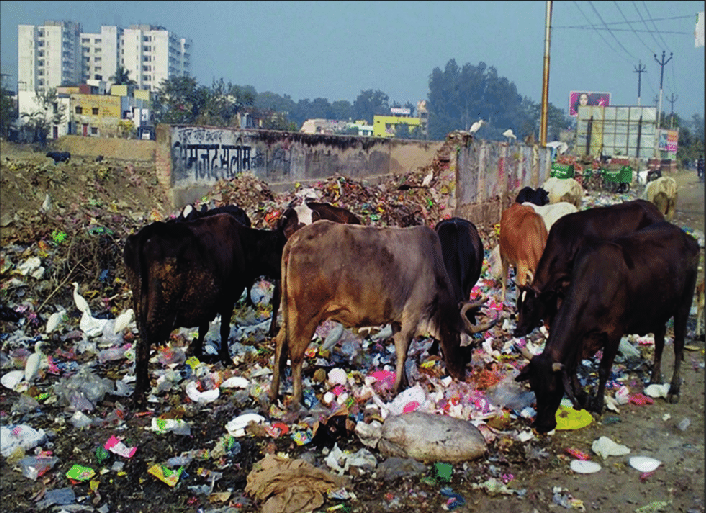CONTAMINATION OF LIVESTOCK PASTURE
what is contamination of livestock pasture ?
Contamination of livestock pasture can be define as the land where animals like cows,
sheep, and goats graze has become polluted or dirty.
This pollution can come from
various sources, such as chemicals, waste, or harmful bacteria. When the pasture
is contaminated, it can make the animals sick, reduce the quality of the grass they
eat, and potentially make the meat or milk from these animals unsafe for humans to consume. Essentially,
it means the pasture is not clean and healthy for the animals to graze on.
Causes of contamination of livestock pasture
-
Chemical Runoff: Pesticides, herbicides, and fertilizers from nearby fields can wash into pastures, introducing harmful chemicals into the soil and water.
-
Industrial Pollution: Factories and industrial sites can release pollutants into the air and water, which can then settle on pastures.
-
Animal Waste: Manure from livestock can accumulate and not decompose properly, leading to the buildup of harmful bacteria and nutrients that can pollute the pasture.
-
Water Contamination: If a water source, such as a stream or pond, that the pasture relies on becomes polluted (e.g., from agricultural runoff, industrial spills, or sewage leaks), it can contaminate the pasture.
-
Soil Degradation: Overgrazing can lead to soil erosion and loss of vegetation, which can make the land more susceptible to contamination from other sources.
-
Introduction of Invasive Species: Non-native plants or animals can bring diseases or disrupt the natural balance of the pasture, leading to contamination.
-
Improper Disposal of Waste: Dumping of household or industrial waste on or near pastures can introduce harmful substances into the environment.
-
Airborne Pollutants: Pollutants from vehicles, factories, or agricultural activities can settle on pastures, contaminating the grass and soil.
-
Infectious Diseases: Diseases can spread through animal populations via contaminated pastures, especially if one animal becomes a carrier of a disease and infects others through shared grazing areas.
Effect of contamination of livestock pasture
-
Animal Health Issues: Livestock grazing on contaminated pastures can suffer from various health problems, including digestive issues, respiratory problems, and even poisoning. Chronic exposure can lead to weakened immune systems and increased susceptibility to diseases.
-
Reduced Quality of Meat and Milk: Animals that consume contaminated feed can produce meat, milk, and other products that are of lower quality. These products may contain harmful residues that can pose risks to human health.
-
Spread of Disease: Contaminated pastures can become breeding grounds for harmful bacteria and parasites, which can spread to the livestock and, potentially, to humans who come into contact with the animals or their products.
-
Economic Losses: Sick animals and reduced product quality can lead to significant financial losses for farmers. Costs may include veterinary care, decreased productivity, and loss of marketability of products.
-
Environmental Damage: Contaminants can harm the soil and water quality of the pasture, leading to long-term environmental degradation. This can affect not only the current livestock but also future use of the land.
-
Food Safety Concerns: Contaminated livestock products can enter the human food chain, leading to potential health risks for consumers. This can result in foodborne illnesses and loss of consumer confidence in certain products or brands.
-
Regulatory and Legal Issues: Farmers may face fines, sanctions, or legal actions if their livestock products are found to be contaminated and pose a risk to public health. They may also need to comply with stricter regulations and remediation efforts to restore the pasture's safety.
-
Biodiversity Loss: Contaminants can affect not only livestock but also other wildlife in the area, leading to a decrease in biodiversity and disruption of local ecosystems.
Prevetion from contamination of livestock pasture
-
Waste Management: Properly manage and dispose of animal waste to prevent buildup and contamination.
-
Eco-friendly Chemicals :Use environmentally safe pesticides, herbicides, and fertilizers to minimize chemical runoff.
-
Soil and Water Monitoring: Regularly test soil and water quality to detect and address contamination early.
-
Rotational Grazing:Implement rotational grazing to prevent overgrazing and maintain pasture health.
-
Buffer Zones : Establish buffer zones around water sources to reduce pollution from runoff.
-
Proper Disposal: Ensure proper disposal of industrial and household waste away from pastures.

